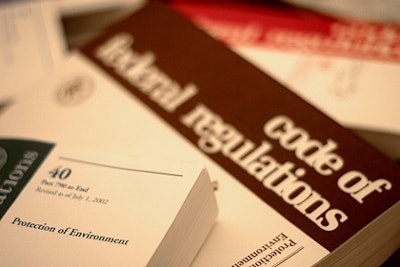
Here's how to avoid the “red lights” and navigate the “yellow lights” of antitrust law.
In the first column in this series, we discussed how antitrust laws are the traffic lights for business. The focus of this column is the most important antitrust “red light” – horizontal price fixing – and several business practices that, while common, are actually “yellow lights” that can lead to significant antitrust risk if not undertaken with care.
What is Horizontal Price-Fixing?
Horizontal price-fixing occurs when two or more competitors conspire to set prices, price levels, or price-related terms for their goods or services. With very limited exceptions, price-fixing is per se illegal, regardless of its reasonableness or actual effect on competition. As a result, price-fixing is serious business. The fines and criminal sentences discussed in the first column of this series all arise from Department of Justice investigations into price-fixing.
Beware. Agreements among competitors may constitute price-fixing even where they do not involve the ultimate price of a product. Examples of unlawful price-fixing arrangements include agreements between competitors on:
- A method of quoting prices.
- Uniform or standard trade-in allowances.
- Price differentials between grades of production.
- Percentage of functional discounts.
- Price or feature advertising.
- Excluding a low price competitor from a trade show.
- Shipping or credit terms.
Other types of agreements, such as those that interfere with competitive bidding or seek to control production, also have an effect on price and can raise serious antitrust concerns.
Price-fixing has been per se illegal as long as there have been antitrust laws. Thus, most price-fixing is not accomplished by express agreement, and direct evidence of collusion is rare (although there are some astonishing exceptions). Generally, collusion is accomplished subtly and is, therefore, proven by inference from otherwise common business practices involving communications and cooperation between competitors. That makes it important to be aware of what common practices create that risk, and how to lawfully engage in them to minimize risk.
Exchanging Information with Competitors
As a general rule, while not illegal per se, it is best never to discuss prices, costs, production, purchase terms, territories, or customers with competitors. While courts recognize that the exchange of price information can in some cases increase economic efficiency and make markets more, rather than less, competitive, direct price exchanges are routinely deemed evidence of a scheme that violates the antitrust laws.
Price data is best shared by competitors, if at all, only indirectly and in ways that make the information disseminated to competitors cumulative and generic. Even where the information exchange is done carefully and with the best of intentions, the most important factor in determining whether the law has been violated is whether there is a demonstrable anti-competitive price effect.
Although the exchange of cost information is less problematic from an antitrust perspective, the same cautions apply. Care should also be taken in exchanging credit, production, and other confidential business information because each can, and does, affect the ultimate price of a product.
The greatest danger that arises from the exchange of sensitive information among competitors is that it creates one more fact from which a jury may be allowed to infer a per se illegal price-fixing conspiracy. It is not difficult to imagine a jury finding that a conspiracy exists where competitors exchange price lists and their respective prices subsequently rise to the same level, even if the pricing was purely coincidental and innocent.
Gathering of Competitor Information
Companies certainly may and do seek information about their competitors, but they should do so from a source other than the competitor. For example, a company could legitimately obtain a competitor’s price list from a distributor or from a public bid document.
Because of the inferences that can be drawn from the use of that information, however, any employee receiving a competitive price list should contemporaneously document in writing when, where, how, and from whom the price list was received.
That will help ensure that, if the company faces an antitrust suit years later, the company can prove it received the list from someone other than a competitor. As information becomes increasingly available on the web pages of competitors, a company may also find useful information there, subject to appropriate documentation of the public source.
It is also common for trade associations to collect information in the form of sales and production data from individual members, aggregate that data, and disseminate it to the association’s membership. This, too, is generally permissible; provided that the trade association takes care to assure that the information is sufficiently aggregated so that the association is not merely acting as a conduit between competitors to exchange sensitive information.
Where, however, the relevant market is concentrated, even an exchange of public information may be considered create the inference of an agreement among members of the association to curtail production and raise prices by signaling planned behavior. Thus, where a concentrated market exists, it is prudent not only to avoid price information exchanges with competitors, but to consult legal counsel before participating in, or responding to, any trade association activities or industry analyst’s survey or request for price information, including discounts, rebates, shipping and credit terms.
Joint Purchasing & Other Competitor Collaboration Arrangements
Joint purchasing agreements can be lawful because their effects can be pro-competitive. Because of the prevalence of such arrangements, as well as other competitor collaborations for joint research and development, production, marketing, distribution, and sales, the Federal Trade Commission and the U.S. Department of Justice adopted formal Antitrust Guidelines for Collaborations Among Competitors in April 2000.
These guidelines and subsequent interpretations by both agencies provide an analytical framework and specific “safe harbors” based on factors like market share, market concentration, and the scope and length of the collaboration, all of which help assess whether the proposed joint activity is more or less likely to achieve efficiencies that will benefit consumers.
In general, the higher the market share of the competitors individually, or as a proposed group, the stricter the scrutiny that will be applied, but any business contemplating a collaborative effort with one or more of its competitors should review the Guidelines carefully.
Other Non-Price-Related Agreements
Some common horizontal agreements do not involve price, but are nonetheless often deemed anti-competitive and therefore illegal. Perhaps the most familiar are concerted refusals to deal or group boycotts—arrangements in which those at the same horizontal level of the market agree not to deal with competitors, customers or suppliers.
The intent of the boycott is to disadvantage competitors and it is often accomplished by cutting off a competitor’s access to a necessary supply, facility or market, either by direct denial, or through other coercion. These concerted refusals to deal are often the subject of private antitrust suits (and treble damages claims) and complaints to antitrust regulatory authorities.
They also present the highest risk that a manufacturer will join a horizontal conspiracy among its distributors and find its otherwise legitimate business plans deemed per se illegal. Even a series of purportedly vertical relationships between a dealer and its various suppliers that results in the suppliers boycotting the dealer’s competitors may violate the antitrust laws.
To avoid this potential risk, suppliers and dealers need to follow some simple rules:
- Suppliers should never agree with competitors to refuse to sell products to common dealers or customers.
- A supplier should never agree with a group of its customers or dealers not to deal with some other dealer or customer.
- Competing dealers must remember that the antitrust laws view them as competitors and view any horizontal agreement between them harshly.
- Aggrieved dealers should complain directly to the supplier without involving other dealers, and the supplier should do no more than listen politely, taking action, if any, unilaterally without involving the complaining dealer further, much less agreeing on a course of action.
Horizontal agreements to divide markets or allocate customers are also per se unlawful, and run a close second to price-fixing schemes in number of agreements condemned. Bid rigging, for example, is considered an agreement to allocate customers and has resulted in jail terms for participants. Market divisions among potential, as well as actual competitors, are also unlawful.
Customer allocations and territory divisions by and among competitors are generally condemned because they are indirect forms of production or output restrictions. For example, exclusive distributorship agreements between competitors that restrict one party from competing in the market of another party may constitute a horizontal allocation that denies consumers in both markets the benefits of competition on price and quality.
In contrast, courts have recognized that some products could not be offered without limited cooperation between competitors. For example, professional sports leagues could not produce games without agreements on schedules, rules, and certain splits of gate receipts.
In these situations, where horizontal market and customer allocations are ancillary to an integration of economic activities by the parties and where those integrated economic activities are actually pro-competitive, courts have judged the actions under the rule of reason.
Covenants not to compete are analyzed under the rule of reason. Covenants not to compete have many business and legal implications, but in the antitrust context are usually examined for reasonableness with regard to time, territory, and type of product. Plaintiffs bear a heavy burden to prove that a covenant not to compete violates the Sherman Act when the covenants arise as part of a legitimate business transaction.
To be lawful, restrictive covenants need only be:
- Ancillary to the main purpose of the lawful contract.
- Neither imposed by a party with monopolistic power, nor in furtherance of a monopoly.
- Partial in nature and reasonably limited in time and scope.
- No greater than necessary to afford fair protection to the parties, and not so extensive as to interfere with the interest of the public.
To succeed on a claim for a § 1 violation based on a covenant not to compete, a defendant must have knowingly enforced an invalid non-competition agreement and the plaintiff must show an adverse impact on competition in the relevant market stemming from enforcement of the provision, either through direct evidence (for instance, showing a decrease in supply) or a more elaborate showing of adverse effects on competition without pro-competitive justification. Thus, as a general rule, unless a covenant not to compete amounts to an allocation of customers or markets, they survive antitrust challenge.
In short, while competitor collaborations can occur on a number of levels, and often have significant, beneficial effects on the market, they can also have precisely the opposite effect. As a rule of thumb, it is always prudent to start with the assumption that any collaboration among competitors is a yellow light, and potentially a red light in practice if not policy, more than justifying advance consultation with the legal department before moving forward.
For more information, read Pricing Issues And Antitrust Law . Roberta F. Howell is a partner at Foley & Lardner LLP in Madison, Wis. She is co-chair of the firm’s Distribution and Franchise Practice.


















